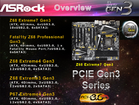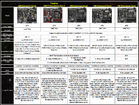- Joined
- Oct 9, 2007
- Messages
- 47,853 (7.38/day)
- Location
- Dublin, Ireland
| System Name | RBMK-1000 |
|---|---|
| Processor | AMD Ryzen 7 5700G |
| Motherboard | Gigabyte B550 AORUS Elite V2 |
| Cooling | DeepCool Gammax L240 V2 |
| Memory | 2x 16GB DDR4-3200 |
| Video Card(s) | Galax RTX 4070 Ti EX |
| Storage | Samsung 990 1TB |
| Display(s) | BenQ 1440p 60 Hz 27-inch |
| Case | Corsair Carbide 100R |
| Audio Device(s) | ASUS SupremeFX S1220A |
| Power Supply | Cooler Master MWE Gold 650W |
| Mouse | ASUS ROG Strix Impact |
| Keyboard | Gamdias Hermes E2 |
| Software | Windows 11 Pro |
ASRock today is one of the top-three motherboard vendors in terms of sales volumes, but it must have been a long and tiring journey getting there in the market. One of the design philosophies of ASRock motherboards has been to experiment with unique features, odd chipset-socket combinations, odd and exotic expansion slot selection, and so on. Today, ASRock may not be the only motherboard vendor with products featuring PCI-Express 3.0, but it looks like the company is of the idea to make the new interconnect a major selling point, of the kind USB 3.0 and SATA 6 Gb/s became a couple of years ago. The company is planning an entire series of socket LGA1155 motherboards targeting mid-thru-high end price-points, featuring PCI-Express 3.0 graphics slots.
PCI-E 3.0 finds itself in the same spot USB 3.0 and SATA 6 Gb/s found themselves when they made an entry into client motherboards. There are close to no products that use it. So while it might look gimmicky, PCI-E 3.0 could add a thin layer of future-proofing to the offer, if you're in the market for a new socket LGA1155 motherboard. ASRock is readying no less than five motherboards, four based on the Z68 Express chipset, and one on the P67 Express (B3). All model names are tagged with "Gen3" to convey that it features PCI-E 3.0. The series includes the Z68 Extreme Extreme7 Gen3 at the very top of the pile, with its swanky-looking heatsinks, followed by the Fatal1ty-branded Z68 Profess1onal Gen3, Z68 Extreme4 Gen3, Z58 Extreme3 Gen3, and the P67 Extreme4 Gen3.


The Z68 Extreme7 Gen3 is filled to the brim with connectivity options. It looks to be featuring a unique PCI-Express arrangement, probably thanks to a new PCI-E bridge chip. A single Gen 3 x16 link comes from the CPU, this link can be set to either run a single x16 slot at x16 Gen 3.0, or a bridge chip that gives out two PCI-Express 2.0 x16 links. The two x16 Gen 2.0 links can then drive up to three slots, either in x16/NC/x16, or x16/x8/x8. The rest of the physical x16 slots are probably x4. This aside, the Extreme7 Gen3 features six USB 3.0 and six SATA 6 Gb/s ports.
The Z68 Fatal1ty Gen3 features three PCI-E x16 slots, of which two are PCI-E 3.0, and the third is PCI-E 2.0. Again a vague electrical configuration is given out that leaves us with a lot to speculate, but the board ends up with support for 3-way SLI and CrossFireX. Most of the unique features of previous ASRock Fatal1ty motherboards such as the Fatal1ty Mouse Port (a pair of low-latency/high-polling USB ports), are available. The Z68 Extreme4 Gen3 trails it with two PCI-Express 3.0 x16 (electrical x8/x8); followed by Z68 Extreme3, which has a similar feature-set, except that it features just two each of SATA 6 Gb/s and USB 3.0 ports. Lastly, there's the P67 Extreme4 Gen3, which has an identical number of USB 3.0 and SATA 6 Gb/s ports as the Z68 Extreme4 Gen3, but lacks Flexible Display Interface and Smart Response Technology, making it probably the cheapest of the lot.
PCI-Express Gen 3.0 is the latest device interconnect technology, it features 1 GB/s of bandwidth per lane, per direction.
View at TechPowerUp Main Site
PCI-E 3.0 finds itself in the same spot USB 3.0 and SATA 6 Gb/s found themselves when they made an entry into client motherboards. There are close to no products that use it. So while it might look gimmicky, PCI-E 3.0 could add a thin layer of future-proofing to the offer, if you're in the market for a new socket LGA1155 motherboard. ASRock is readying no less than five motherboards, four based on the Z68 Express chipset, and one on the P67 Express (B3). All model names are tagged with "Gen3" to convey that it features PCI-E 3.0. The series includes the Z68 Extreme Extreme7 Gen3 at the very top of the pile, with its swanky-looking heatsinks, followed by the Fatal1ty-branded Z68 Profess1onal Gen3, Z68 Extreme4 Gen3, Z58 Extreme3 Gen3, and the P67 Extreme4 Gen3.


The Z68 Extreme7 Gen3 is filled to the brim with connectivity options. It looks to be featuring a unique PCI-Express arrangement, probably thanks to a new PCI-E bridge chip. A single Gen 3 x16 link comes from the CPU, this link can be set to either run a single x16 slot at x16 Gen 3.0, or a bridge chip that gives out two PCI-Express 2.0 x16 links. The two x16 Gen 2.0 links can then drive up to three slots, either in x16/NC/x16, or x16/x8/x8. The rest of the physical x16 slots are probably x4. This aside, the Extreme7 Gen3 features six USB 3.0 and six SATA 6 Gb/s ports.
The Z68 Fatal1ty Gen3 features three PCI-E x16 slots, of which two are PCI-E 3.0, and the third is PCI-E 2.0. Again a vague electrical configuration is given out that leaves us with a lot to speculate, but the board ends up with support for 3-way SLI and CrossFireX. Most of the unique features of previous ASRock Fatal1ty motherboards such as the Fatal1ty Mouse Port (a pair of low-latency/high-polling USB ports), are available. The Z68 Extreme4 Gen3 trails it with two PCI-Express 3.0 x16 (electrical x8/x8); followed by Z68 Extreme3, which has a similar feature-set, except that it features just two each of SATA 6 Gb/s and USB 3.0 ports. Lastly, there's the P67 Extreme4 Gen3, which has an identical number of USB 3.0 and SATA 6 Gb/s ports as the Z68 Extreme4 Gen3, but lacks Flexible Display Interface and Smart Response Technology, making it probably the cheapest of the lot.
PCI-Express Gen 3.0 is the latest device interconnect technology, it features 1 GB/s of bandwidth per lane, per direction.
View at TechPowerUp Main Site






